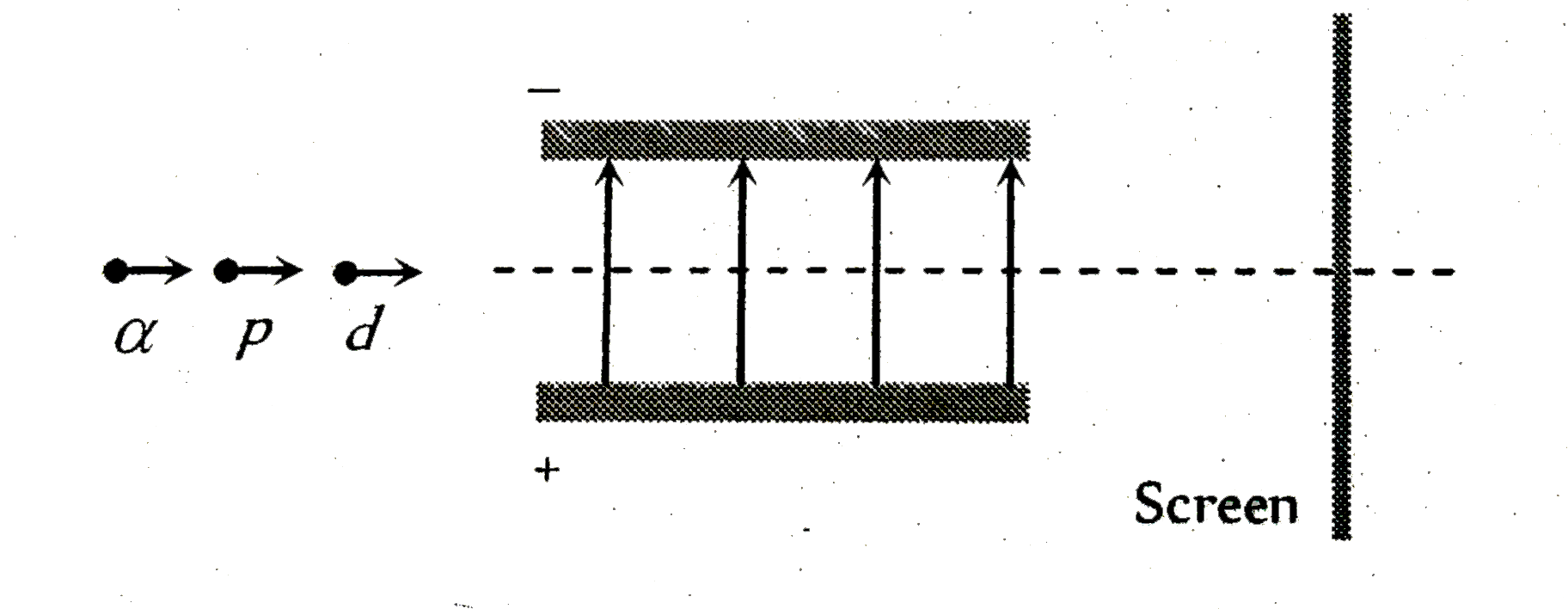Proton, deuteron and alpha particle have same momentum. They are projected in the same magnetic field. Then choose the correct ratio of forces and their speeds.
Fp:Fd:Fa=4:2:1,Vp:Vd:Va=2:1:1
Fp:Fd:Fa=2:1:1,Vp:Vd:Va=4:2:1
Fp:Fd:Fa=1:2:1,Vp:Vd:Va=1:2:1
Fp:Fd:Fa=1:1:1,Vp:Vd:Va=1:1:1
To solve the problem, we need to analyze the forces and speeds of the proton, deuteron, and alpha particle when they are projected in the same magnetic field with the same momentum.
1. Identify the Particles and Their Properties:
- Proton (charge = q, mass = m)
- Deuteron (charge = q, mass = 2m)
- Alpha particle (charge = 2q, mass = 4m)
2. Momentum Condition:
We know that the momentum P is the same for all three particles:
P=mv
Therefore, for each particle:
- For Proton: P=mvp → vp=Pm
- For Deuteron: P=2mvd → vd=P2m
- For Alpha Particle: P=4mvα → vα=P4m
3. Calculate the Ratios of Speeds:
The speeds can be expressed as:
vp:vd:vα=Pm:P2m:P4m
Simplifying this gives:
vp:vd:vα=4:2:1
4. Calculate the Forces:
The force F on a charged particle in a magnetic field is given by:
F=qvBsin(θ)
Since θ is constant and does not affect the ratio, we can ignore it. Thus, the forces for each particle are:
- For Proton: Fp=qvpB=q(Pm)B
- For Deuteron: Fd=qvdB=q(P2m)B
- For Alpha Particle: Fα=2qvαB=2q(P4m)B
5. Calculate the Ratios of Forces:
Now we can express the ratios of the forces:
Fp:Fd:Fα=q(Pm):q(P2m):2q(P4m)
This simplifies to:
Fp:Fd:Fα=Pm:P2m:P2m
Further simplifying gives:
Fp:Fd:Fα=2:1:1
Final Ratios:
- Speed Ratio: vp:vd:vα=4:2:1
- Force Ratio: Fp:Fd:Fα=2:1:1
- Proton (charge = q, mass = m)
- Deuteron (charge = q, mass = 2m)
- Alpha particle (charge = 2q, mass = 4m)
We know that the momentum P is the same for all three particles:
P=mv
Therefore, for each particle:
- For Proton: P=mvp → vp=Pm
- For Deuteron: P=2mvd → vd=P2m
- For Alpha Particle: P=4mvα → vα=P4m
The speeds can be expressed as:
vp:vd:vα=Pm:P2m:P4m
Simplifying this gives:
vp:vd:vα=4:2:1
The force F on a charged particle in a magnetic field is given by:
F=qvBsin(θ)
Since θ is constant and does not affect the ratio, we can ignore it. Thus, the forces for each particle are:
- For Proton: Fp=qvpB=q(Pm)B
- For Deuteron: Fd=qvdB=q(P2m)B
- For Alpha Particle: Fα=2qvαB=2q(P4m)B
Now we can express the ratios of the forces:
Fp:Fd:Fα=q(Pm):q(P2m):2q(P4m)
This simplifies to:
Fp:Fd:Fα=Pm:P2m:P2m
Further simplifying gives:
Fp:Fd:Fα=2:1:1
- Speed Ratio: vp:vd:vα=4:2:1
- Force Ratio: Fp:Fd:Fα=2:1:1
Topper's Solved these Questions
- JEE MAIN 2021BOOK - JEE MAINS PREVIOUS YEARCHAPTER - JEE MAIN 2021EXERCISE - SECTION-A
80 Videos
- JEE MAIN 2021BOOK - JEE MAINS PREVIOUS YEARCHAPTER - JEE MAIN 2021EXERCISE - SECTION-B
40 Videos
- JEE MAINBOOK - JEE MAINS PREVIOUS YEARCHAPTER - JEE MAINEXERCISE - All Questions
473 Videos
- JEE MAIN 2022BOOK - JEE MAINS PREVIOUS YEARCHAPTER - JEE MAIN 2022EXERCISE - Question
492 Videos
Similar Questions
A proton, deutron and α particle are moving with same momentum in uniform magnetic field. The ratio of magnetic forces acting on them is___and their speed are in ratio____
View SolutionA deuteron and an alpha particle having same momentum are in turn allowed to pass through a magnetic field B, acting normal to the direction of motion of the particles. Calculate the ratio of the radii of the circular paths described by them.
View Solution
Knowledge Check
A proton, deutron and α particle are moving with same momentum in uniform magnetic field. The ratio of magnetic forces acting on them is___and their speed are in ratio____
A1:2:4and2:1:1B2:1:1and4:2:1C4:2:1and2:1:1D1:2:4and1:1:2If an electron and a proton having same momenta enter perpendicular to a magnetic field, then
Acurved path of electron and proton will be same ( ignoring the sense of revolution)Bthey will move undeflectedCcurved path of electron is more curved than that of the protonDpath of proton is more curved.An electron, a proton, a deuteron and an alpha particle, each having the same speed are in a region of constant magnetic field perpendicular to the direction of the velocities of the particles. The radius of the circular orbits of these particles are respectively Re,Rp,Rd and Rα. It follows that :
ARe=RpBRp=RdCRd=RαDRp=Rα
If a proton, deuteron, and alpha particle on being accelerated by the same potential difference enters perpendicular to the magnetic field, then the ratio of their kinetic energies is
View SolutionAn electron, a proton, a deuteron and an alpha particle, each having the same speed are in a region of constant magnetic field perpendicular to the direction of the velocities of the particles. The radius of the circular orbits of these particles are respectively Re,Rp,Rd and Rα. It follows that :
View SolutionAn electron, a proton, a deuteron and an alpha particle, each having the same speed are in a region of constant magnetic field perpendicular to the direction of the velocities of the particles. The radius of the circular orbits of these particles are respectively Re,Rp,Rd and Rα It follows that
View SolutionA proton, a deutron and an α-particle having the same momentum, enters a region of uniform electric field between the parallel plates of a capacitor. The electric field is perpendicular to the initial path of the particles. Then the ratio of deflections suffered by them is

View SolutionProton , deuton and alpha particle of same kinetic energy are moving in circular trajectories in a constant magnetic field. The radii of proton , deuteron and alpha particle are respectively rp,rdandrα. Which one of the following relation is correct?
View Solution
